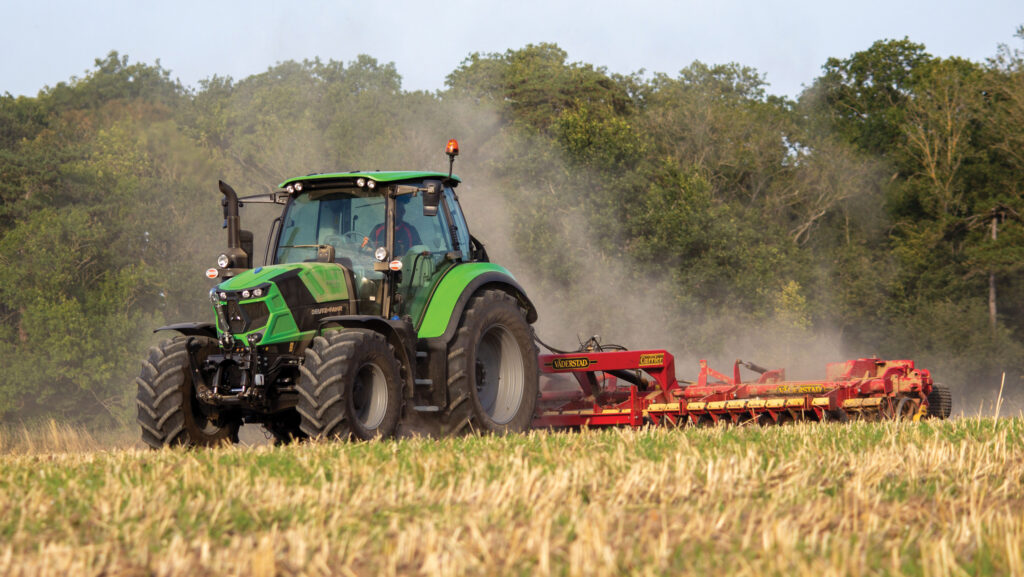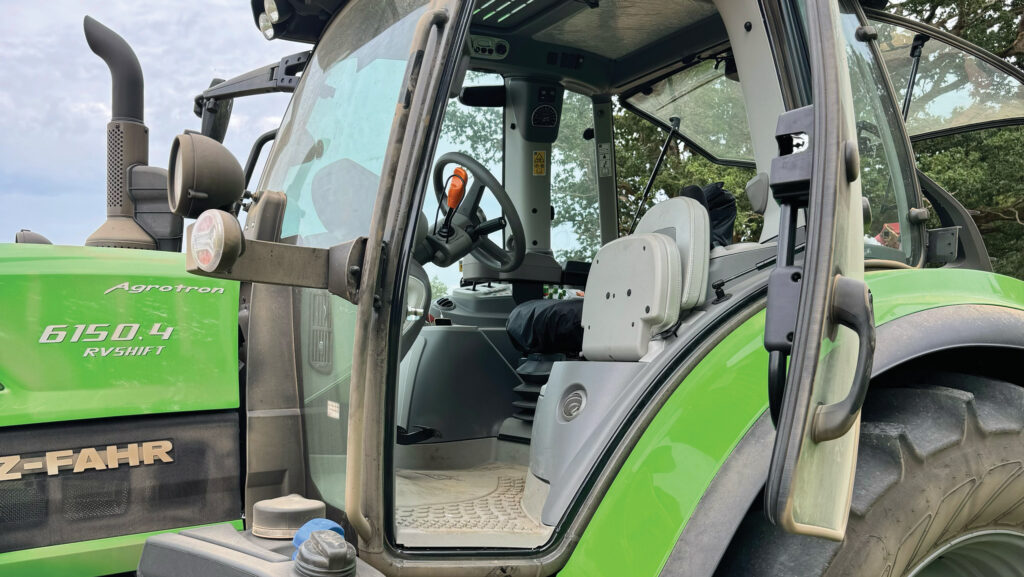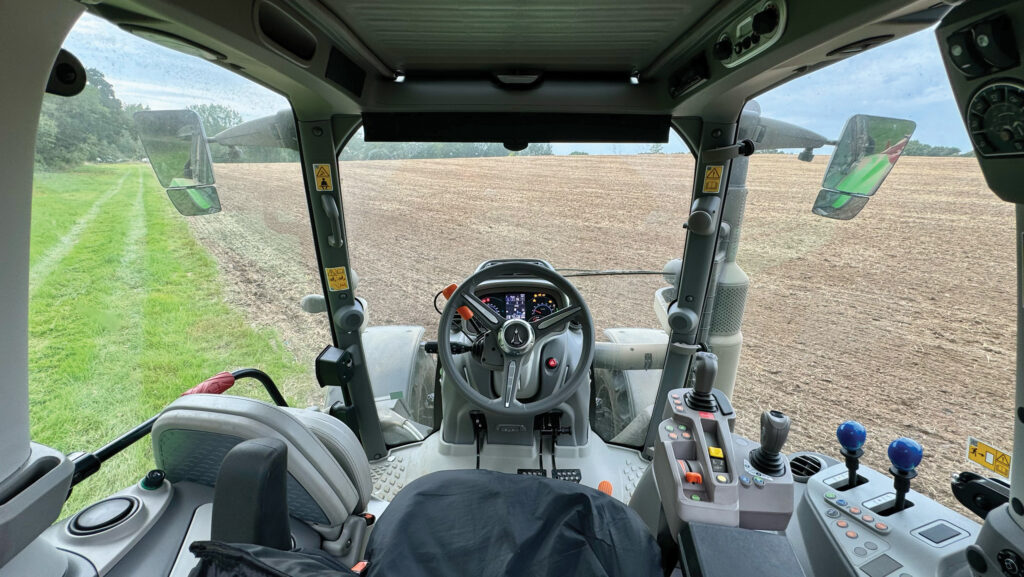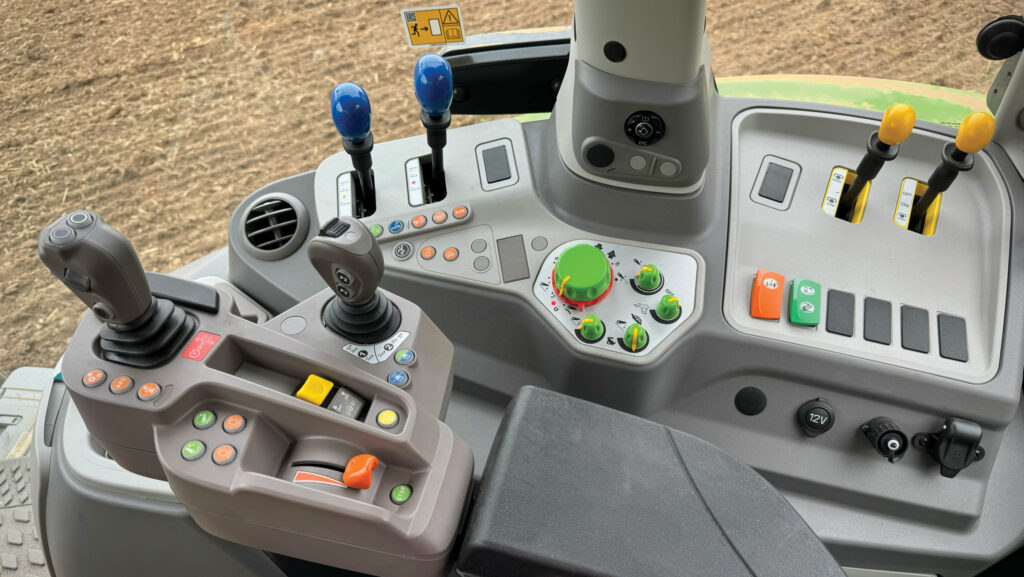On test: Deutz-Fahr 6150.4 with peculiar RVshift transmission
 © MAG/Oliver Mark
© MAG/Oliver Mark Postnatal electronic surgery has transformed the Deutz family’s CVT transmission into a faux powershift that aims to offer the best of both worlds.
This non-binary gearbox, born a TTV at the firm’s Italian factory but now identifying as an RVshift, has gained 20 pseudo speeds without the customary combination of friction plates and clutch packs.
In presenting as a powershifter, but retaining all the stepless bits, this non-conformist either offers the drivetrain traits of both – or neither.
See also: Driver’s view: Why Norfolk grower runs trio of Deutz 7250s
The “full powershift concept” setup is available on six four-cylinder tractors in the Deutz-Fahr range.
We’re focusing on the biggest of the 6.4 models, the 156hp 6150.4, which, power aside, is largely identical to its siblings – the 136hp 6130.4 and 147hp 6140.4.
Because the transmission comes from Deutz’s smaller fruit tractors, list prices for these are about £14,000 cheaper than the equivalent, but heavier-duty 6.4 TTV versions.
Crucially, the firm has no powershift alternatives against which to pitch them.
There’s also a lighter-weight RVshift for the smaller-frame 6C series that runs from the 126hp 6115 C to the 143hp 6135 C.
These too are available as TTVs (plus £5,000) or Powershifts (minus £6,000), too.
How does it work?
For the avoidance of doubt, the RVshift is a CVT. There are no extra electronics or trouble-prone sensors – Deutz has simply fiddled with the software to make it feel like a powershift.
To illustrate the point, a computer whizz with the necessary nous could, in theory, revert it back to stepless drive.
From a driver’s perspective, the only difference between TTV and RV is the more basic armrest-mounted joystick in the cab.
In manual mode – presumably the more popular means of control given a bona fide CVT version of this tractor is available – the featherlight stick is simply prodded forward or back to hop through the 20 virtual ratios.
It’s remarkably convincing in this regard, but it takes a bit of getting used to, during which the tractor can be embarrassingly easy to stall.
We settled on hoicking up the base revs on the hand throttle to avoid red faces during forward/reverse headland turns.
There’s also an auto function that leaves the tractor to pick the most suitable ratio, two adjustable speed ranges, and a “heavy-duty” setting that engages a reducer on the front of the transmission, doubling the torque it receives and limiting top speed to 31kph.
Operators can either select it manually when hard fieldwork is pending, or find out the hard way.
That’s because it will engage automatically under heavy draft load. Problem is, this involves coming to a momentary standstill that may cause nose to abruptly meet windscreen.

© MAG/Oliver Mark
What are the benefits?
It’s easy to see why the Deutz bean counters like this RVshift concept.
Prior to its launch 18 months ago, the company was devoid of a powershift option for its 6.4-series.
But rather than go to the effort and expense of developing one, or pinning down a third-party supplier, some clever Dick in Deutz HQ concocted a plan to repurpose an existing stepless box for the job.
This means it can push what are effectively the same tractors into a far larger market, particularly in the UK where powershifters remain relatively hot property.
And as well as saving R&D dough, Deutz can keep all the profits on in-house built components which also include the front axle, engine and backend – and it makes the whole production and aftersales processes easier to manage.
The setup has apparently proved popular (relatively speaking – Deutz sold 176 tractors in the UK in 2022) among buyers that prefer the old-schoolish functionality of a stick-shifter.
But there are some broader advantages of having a CVT lurking beneath.
There’s no loss of efficiency through gear changes, they can be easier on diesel when set right, and, in theory, they might last longer – hiccups aside – because there are no clutchplates to wear out. The RVshift is also economical at top speed.
On the flipside, they’re more complicated to fix and more expensive to buy.
While this 3.8-litre, four-cylinder 6150.4 of 156hp lists at £151,274, you can get a 6160.4 Powershift with a slightly bigger 4-litre engine tuned to 161hp (171hp boosted) for £150,979 – a small cost saving and 15 extra horsepower to boot, albeit in basic spec.
Or spend a little more and go bigger with the 6.1-litre, six-cylinder 6160 Powershift (also 161hp/171hp) in the range above for £157,418.

© MAG/Oliver Mark
Any other features?
Yep – far more than the average livestock farmer would care to concern themselves with.
The simplest, and most useful as far as loader work is concerned, is Stop & Go.
This disengages the drive when braking to save declutching – standard fare these days – but it lacks refinement, with the pedals having unnervingly long travel before the brakes suddenly grab.
There’s also an “advanced” mode which will actively hold the tractor still, much like the firm’s “power zero” function on the bigger models.
This and other transmission settings are found in the central third of the dash display, controlled by a set of unremarkable buttons at the base of the B-pillar.
With such little real estate dedicated to configuring the tractor, it leaves a lot of information crammed into a small area.
Ironically, alterations would be far less of a fag on the 8in iMonitor of TTV models.
Though a big screen can be daunting, it does make the search for settings easier.
As well as the window of ratios for field and road modes, operators can fine-tune things such as acceleration rate and the tractor’s preference for economy or power.
This shouldn’t be overlooked in auto-shifting mode, particularly when the workload is varied.
Burdened by a 6m Vaderstad Carrier, we found it best set at around 80% to reduce the tractor’s inclination to shift up, only to bottle it a few seconds later and drop back down again.
Equally though, decreasing it to sub-50% will improve fuel economy in more forgiving circumstances.

© MAG/Oliver Mark
What about the cab?
Deutz-Fahr’s enduring Maxivision cab gets another run out, and it’s as good as ever. Six pencil-thin pillars sit between acres of glass and the trademark second window behind the seat give as good a view as possible of the rear linkage and drawbar.
Thumbs up, too, for the optional square roof window and relatively thin crossmember that splits it and the front screen, the passenger seat-cum-picnic table with generous legroom for friends, and the key-side pocket to perch phones and a family-sized bag of M&Ms.
Downsides are mainly petty: the big mudguards wobble furiously during fieldwork, the door wants slamming shut, and the blowers bellow, making it unnecessarily loud in the cab. Once heard, they can’t be unheard.
The distribution of controls is trademark Deutz, with child-like colour-coding of controls helping to decipher the mysterious acronyms – drivers need to know their ASMs from their APSs.
But all are splattered across the armrest and side console, in easy reach of the seat.
We had the firm’s popular “hybrid” spools, which pairs two electro-hydraulic controls on a second joystick – ideal for loader work – with a brace of manual levers near the window. It’s a setup that should keep everyone happy.
And there’s a smattering of freely assignable buttons on both sticks, two of which can be used to control the forward/reverse shuttle to keep one hand on the wheel during loader work.
Setting them requires some know-how, though. There’s a whiff of noughties Valtras about the lack of user friendliness.
Verdict
Deutz engineers have clearly worked hard to hone the RVshift software, such that it’s a true simulation of a full-powershift tractor.
It’s cheaper than a TTV too, but not as well specced and, arguably, more complicated. Plus, there’s no shortage of powershift options in this sector if that’s what you want.
So other than a ruse to shift more of its own CVT transmissions, it is hard to see exactly where the RVshift fits in.
Likes
- Lightweight transmission joystick
- Good cab visibility
- Mix of electric and mechanical spools
- Economical at top speed
Gripes
- Settings not entirely user friendly
- Grabby Stop & Go braking system
- Transmission adds complication
Deutz-Fahr 6150.4
- Engine 3.8-litre, four-cylinder SDF Farmotion
- Max power 156hp@2,000rpm
- Max torque 663Nm@1,400rpm
- Transmission 20×16 Deutz RVshift CVT
- Lift capacity 5,970kg (9,170kg optional); 3,000kg front
- Hydraulics 90 litre/min (120 litre/min optional)
- Wheelbase 2.56m
- Turning radius 5.1m
- Weight 6.5t
- Gross vehicle weight 10.5t
- List price £151,274
- Approx on-farm price £90,000

